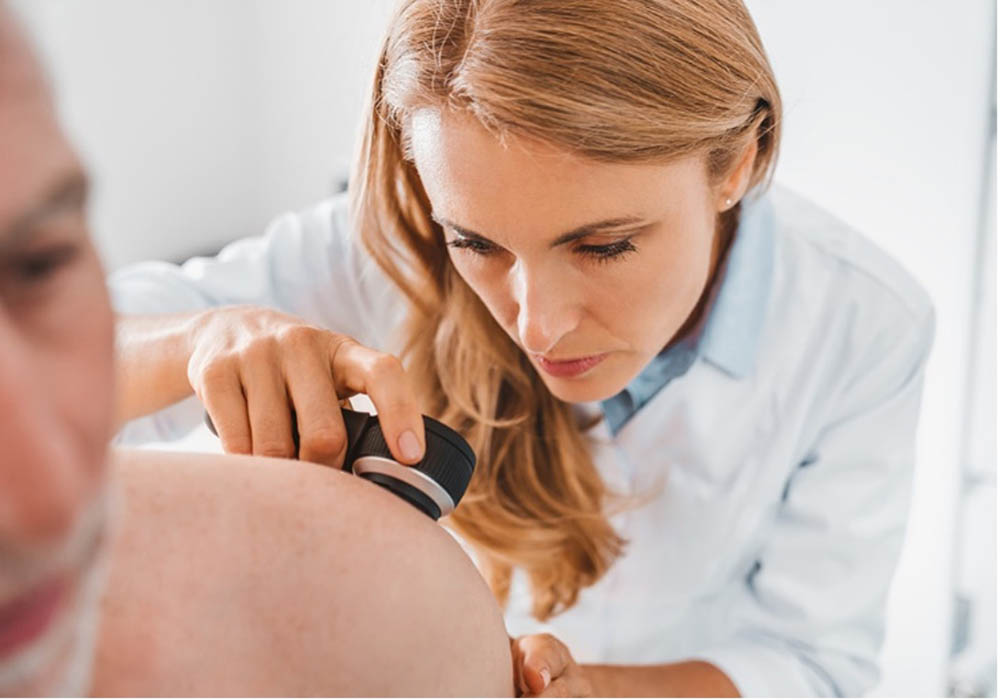Merkel cell carcinoma (MCC) is a rare but aggressive form of skin cancer—although it is 40 times rarer than melanoma, it is 3–5 times more lethal. Approximately 3,000 new cases of MCC are diagnosed every year in the United States, but its incidence is increasing because of enhanced diagnostic techniques and the prevalence of risk factors.
Anatomy
MCC shares similar microscopic features with normal Merkel cells found in the top layer of skin; however, researchers suspect that MCC actually arises from epidermal or dermal stem cells. MCC often presents on sun-exposed skin (most often the head and neck region) and has a less distinctive appearance compared to other types of skin cancer. The tumors can be pimple-like and skin-colored, red, purple, or blue-red. They are not generally painful to palpation but grow at a rapid pace.
Risk Factors
MCC exponentially affects patients older than 70 who were assigned male at birth. More than 90% of patients are Caucasian, and many also have Merkel cell polyomavirus (MCPyV) infection. Other risk factors include immunosuppression (e.g., organ transplant, HIV, other cancer diagnoses that affect the immune system), unprotected ultraviolet (UV) light exposure, and a history of other types of skin cancer.
Treatment Options
Initial treatment may include surgical excision and radiation therapy for localized disease. Metastatic or unresectable MCC may benefit from immune checkpoint inhibitor therapy (e.g., retifanlimab-dlwr, pembrolizumab, avelumab) or chemotherapy (e.g., platinum agents, cyclophosphamide). Prognosis is generally poor, with a five-year overall survival rate of 14% for metastatic disease. Given its rarity, enrollment in clinical trials is important to develop future treatment recommendations.
Nursing Considerations
Because MCC can progress rapidly and treatment becomes more difficult in advanced stages, early detection is key. More than half of MCC cases are misdiagnosed as benign when first assessed and thought to be cysts or other benign skin conditions. When assessing the skin, nurses and patients should remember:
- Appearance: Look for any painless shiny or pearly nodules, lesions, or bumps.
- Location: Pay particular attention to sun-exposed skin (head, neck, eyelids).
- Size: The average tumor size at detection is 1.7 cm, or the diameter of a dime.
- Color: Watch for skin-colored, red, purple, or bluish-red tumors.
Nurses can also use the pneumonic AEIOU:
- A: Asymptomatic lesions that are not painful or tender to palpation
- E: Rapidly expanding lesions
- I: Immunocompromised patient
- O: Age older than 50
- U: UV light–exposed skin
The National Comprehensive Cancer Network recommends that patients at high risk for MCC receive head-to-toe skin assessments monthly, see a dermatologist annually, and practice sun-safe habits such as wearing protective clothing and using a broad-spectrum sunscreen as prevention and early detection strategies. Risk of recurrence is high, with median time to recurrence of eight to nine months. Patients with MCC are also at increased risk for a prior, concurrent, or subsequent second primary malignancy. They require close follow-up with full skin and lymph node exams every three to six months for the first three years.






